AFO Orthotic Prescription
AFO stands for Ankle-Foot Orthosis.
An AFO is used to address instability and weakness in the lower limb and promote a safer and more natural walking motion. It is important to know there are different types of AFOs.
Orthotics Plus is experienced in providing both pre-made and custom-made AFOs to the Melbourne community, with hundreds of successful fittings.
Our patients include adults, paediatrics, WorkCover/TAC patients, NDIS participants and private clients.
Book AFO Assessment Call (03) 9077 6414

Types of AFOs
-
Learn More +
Jointed AFOs
Used for a Variety of Conditions

-
Learn More +
Ground Reaction Ankle Foot Orthoses
GRAFO Lower Limb Support
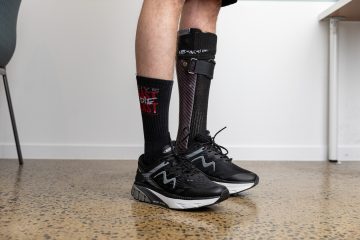
-
Learn More +
PDE
Ankle Foot Orthoses (AFO)
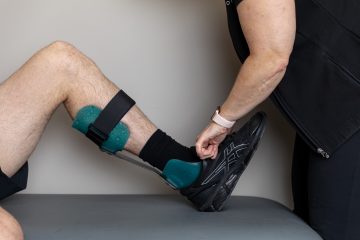
-
Learn More +
Carbon Fibre AFO
Lightweight AFO

-
Learn More +
Propulsion
Dynamic AFO

-
Learn More +
Leafspring AFO
Light, Mostly Used for Foot Drop
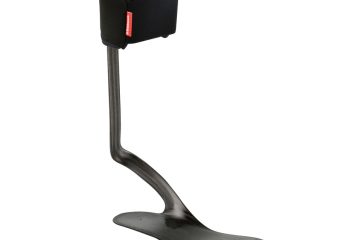
Which Conditions Require an AFO?
They may be used to support people living with a wide range of physical and neurological conditions. Some of these include:
- Stroke
- Cerebral palsy
- Acquired brain injury
- Muscular dystrophy
- Spinal cord injury
- Peripheral nerve damage
- Charcot Marie Tooth
- Spina Bifida
Some examples of presentations requiring an AFO include:
- Lower limb weakness
- Lack of control of the foot and ankle
- Dorsiflexion weakness causing foot drop
- Severe tibialis posterior dysfunction
- Plantarflexion weakness
- Ankle osteoarthritis (requires total immobilisation)
- Plantar flexion contractures (inverse to a dorsiflexion weakness) to help keep the ankle in a neutral position
- Muscle spasticity of the lower limbs
How AFO Prescription Works
Initial Appointment
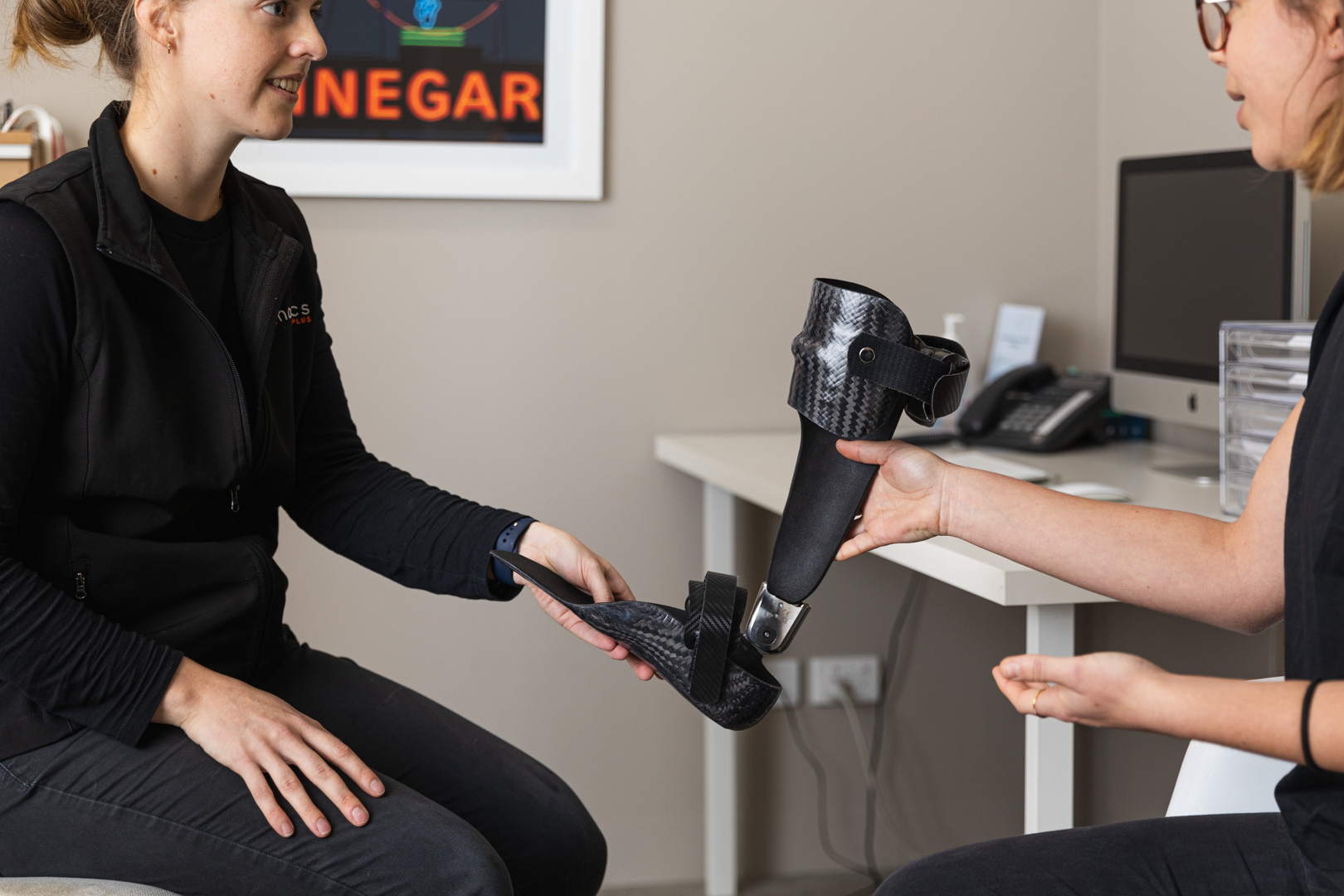
During the initial consultation, which lasts about an hour, we assess the patient’s condition, previous treatments, muscle strength, range of motion, and gait.
We also discuss their goals and any involvement from other healthcare professionals.
Trial
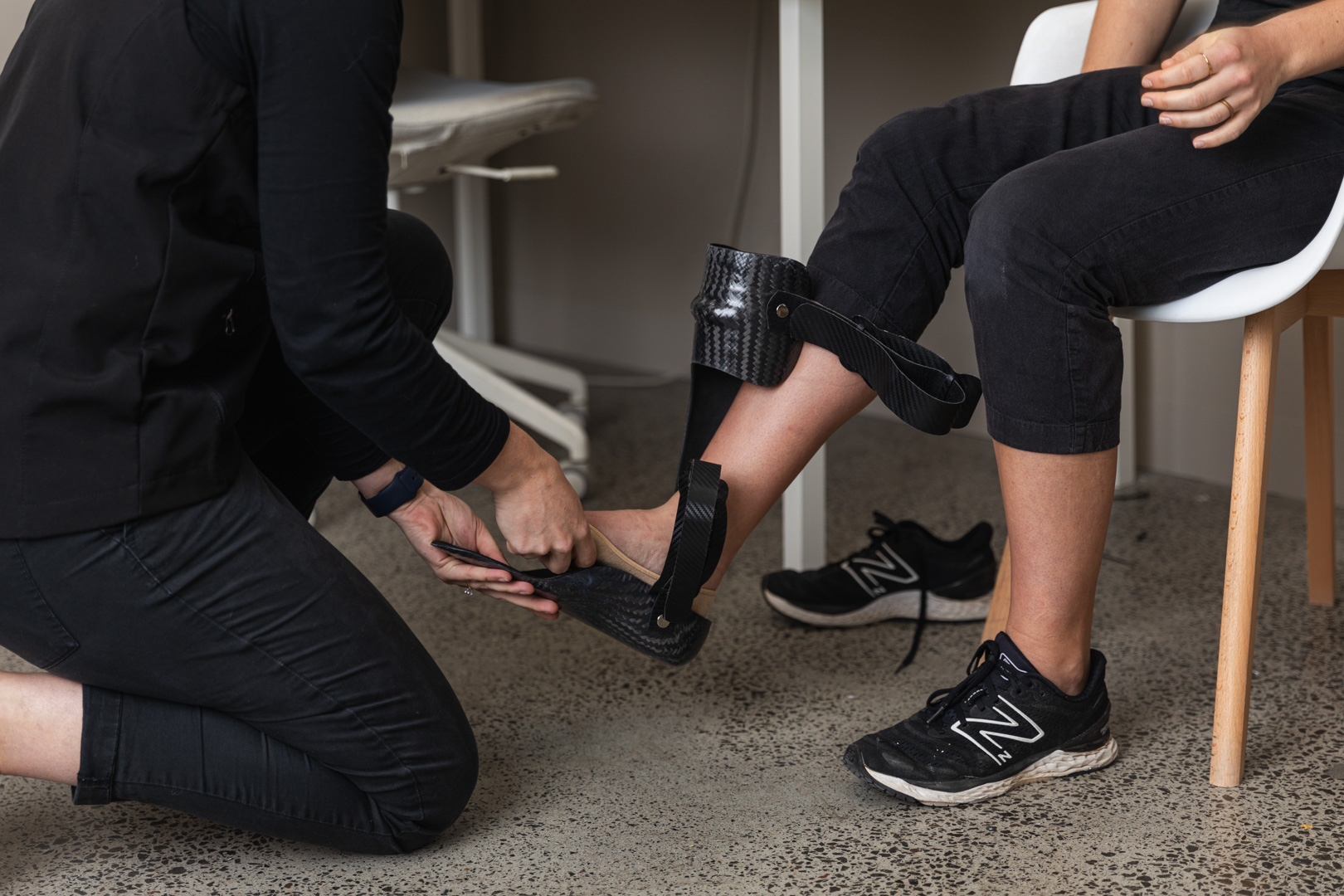
Before finalising the AFO prescription, we arrange a trial or test device if possible.
The patient tests different options (if necessary), and we adjust the AFO in the clinic to simulate the ‘feel’ of the final product’s benefits.
Funding

We will prepare a quotation for yourself or the funding body (such as NDIS) and communicate this over a reasonable period- our aim is under 2 weeks.
Once approved, we proceed to the next step.
Manufacturing

We take a cast or scan of the patient’s leg and manufacture the custom AFO- timeframes depend on the style of AFO.
Before the final fitting, we may conduct a plastic check-fit to ensure proper alignment.
At the final fitting, we adjust the range of motion and ensure the footwear is appropriate.
Rehabilitation

We collaborate with the patient’s physiotherapist to align treatment goals, ensuring that the AFO and rehabilitation are working together toward the same outcomes.
This helps support a methodical approach to achieving optimal function.
Reviews
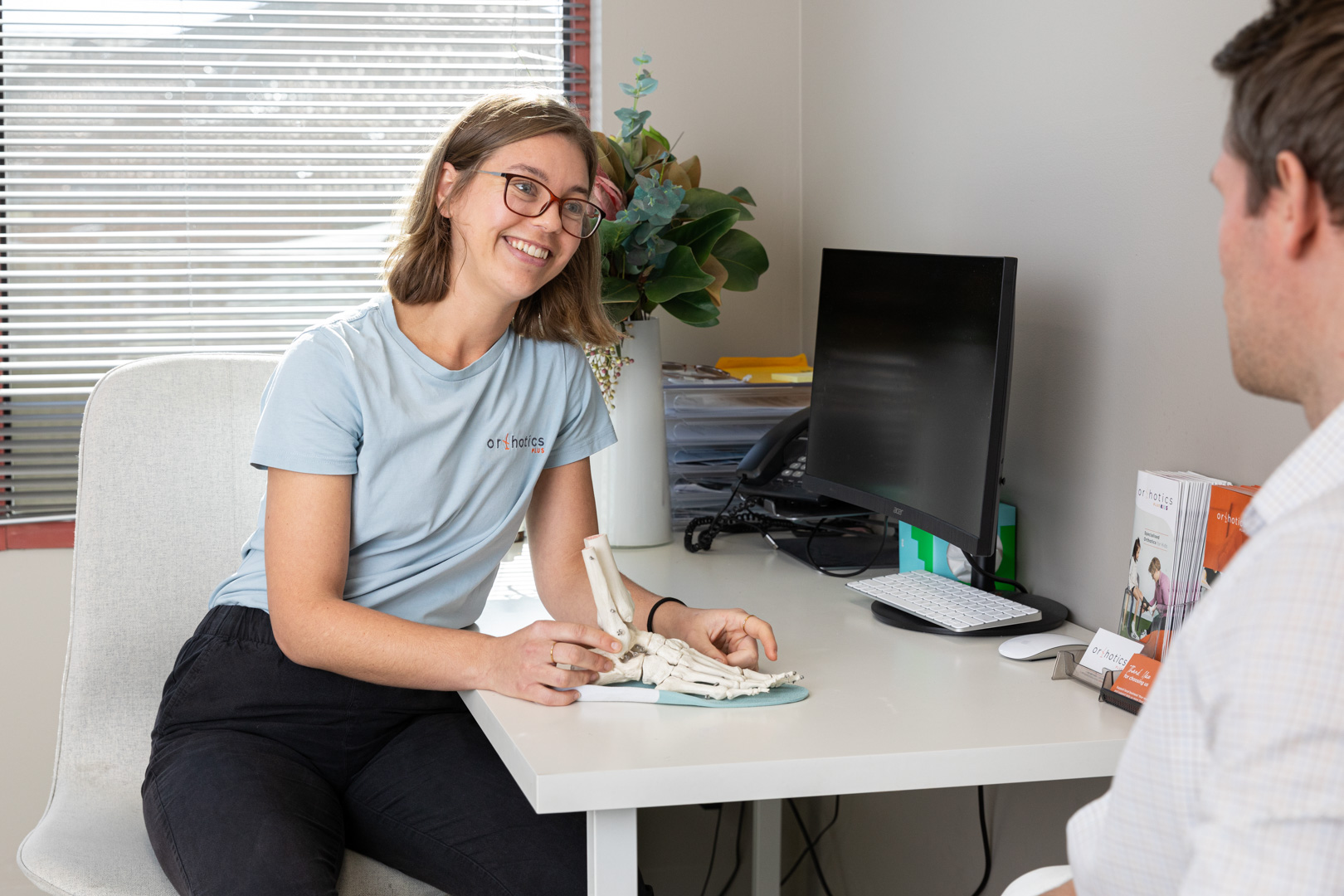
After fitting, we schedule two to three reviews over the first two months to fine-tune the AFO’s fit and function.
Afterwards, we continue with reviews every 6 to 12 months to monitor any changes in the patient’s condition and adjust the AFO as needed.
Ready to Work with Orthotics Plus?
Our senior orthotists each have a minimum of 10 years of active clinical experience and we have hundreds of successful patient outcomes.
We are the experts in the Orthotic management of complex conditions and injuries.
Please note that all our AFO products are warrantied appropriately and we will provide you with ongoing support.
If you are unsure if an AFO would benefit you, a client or a loved one, please reach out and we can assist.

AFO FAQ
The AFO is only as good as the shoe it’s in!
Generally speaking, the person would be required to wear practical shoes, such as runners, light boots, lace up shoes or office shoes to synchronise an AFO.
Footwear such as sandals, ballet shoes or thin flat shoes are not appropriate, but there are a few exceptions which we can discuss with you.
We understand that people may have a preference for more fashionable shoes, in this case, our Orthotist will help you choose new shoes as many options now exist.
Yes, we stock a small range of shoes.
We also have the ability to order shoes from a supplier, and if they’re not the right fit, we have the option of returning them.
We can arrange custom made shoes if needed.
The usage of either of these largely depends on the patient and what we are aiming to achieve.
For example, for a 150kg patient requiring a rigid device, plastic would flex, so we would use carbon fibre laminate, which is stronger.
While carbon fibre laminates are generally stronger, thinner and lighter, they’re more difficult to modify and less flexible after fabrication, so it’s situational.
If a patient has a strong preference for either we will factor this into our prescription.
We recommend long socks that will create a barrier between the skin and the AFO.
The material of the sock is the preference of the client.
Pre-made AFOs are often suitable for people with a simpler presentation and a typical anatomy.
Custom made AFOs are used for patients with a complex clinical presentation or unusual anatomy or if the Orthotist determines this will result in a better outcome.
Most growing children will require a re-assessment approximately every 12 months.
We suggest making an appointment with us ASAP if your child complains of an AFO feeling too tight or you notice rubbing.
We ensure our clinics are sufficiently staffed so you should be able to see your Orthotist within a day or two
There is an array of AFOs that control the ankle and foot in different ways.
AFOs can be pre-made or custom-made. They are typically made out of plastic or carbon fibre. Your Orthotist will guide you on the correct type for your needs.
Ground Reaction Ankle-Foot Orthoses
Typically used for people exhibiting quadricep weakness by applying an anterior force at the knee.
These are often a good solution to enable a patient to stand and walk with more stability and safety.
Leafspring Ankle Foot Orthoses
Leafspring AFO’s focus on lifting the foot during gait.
These designs are very thin and most commonly used for dorsiflexion weakness (foot drop).
Being light, they aren’t suitable for patients requiring higher levels of stability or those with medial/lateral ankle instability
Solid Ankle Foot Orthoses
These are designed to control the foot and ankle at an appropriate angle and provide support in multiple different planes.
We can also gain control at the knee by influencing the ankle and a solid AFO is sometimes suitable for this.
Jointed Ankle Foot Orthoses
These are characterised by a joint mechanism allowing movement in the ankle.
A common design is a joint which allows the ankle to move up (dorsiflexion) but not move down (plantarflexion), if the patient is expereince foot drop.
They can also be made with joints assisting movement in a particular direction or allowing partial movements.
The type of joint and design of the AFO will depending on how much movement the Orthotist wants to allow and your presentation. The goal is safer, pain free, more efficient gait which is sustainable long-term.
Posterior Dynamic Element Ankle Foot Orthoses
They use a carbon fibre strut to connect the calf section to the foot section. The strut can be of varying stiffness depending on the needs of the patient and can be interchanged.
An AFO incorporating a PDE can provide some energy return during walking as well as accommodate postural shifts during stance for better balance and more natural gait.
The PDE can be an effective solution for younger patients, complex patients and those who need a robust orthotic device.
Propulsion Ankle Foot Orthoses
The main difference between a propulsion AFO and any other AFO is the material, weight, and minimalist design.
Propulsion AFOs allow for more energy storage compared to plastic AFOs while still providing good control through the forefoot and stability at the ankle.
The Oxford scale is a tool used to measure muscle strength, which is crucial when prescribing an Ankle-Foot Orthosis (AFO). The scale ranges from 1 to 5:
Grade 1: No movement, indicating severe weakness.
Grade 2: Movement without gravity (e.g., lying down).
Grade 3: Movement against gravity (e.g., sitting and extending the leg).
Grade 4: Movement against minimal resistance.
Grade 5: Full movement against large resistance.
Using the Oxford scale helps determine the type and level of support required in an AFO to match the patient’s muscle strength and mobility needs.
We will also use a different scale and assessment to check for spasticity.
At Orthotics Plus, we follow a “just enough” approach, selecting an AFO that matches your stage of recovery.
This allows you to function effectively while still maintaining or improving your body’s abilities. In the early stages of recovery, we may recommend an AFO that maximises neuroplasticity and rehabilitation, balancing safety and other factors.
Common rehab goals
It is difficult to comment on rehabilitation goals because every patient is different.
The general goal is to improve function while wearing the device and also potentially transition to a lower or no orthotic intervention.
For neurological patients the regeneration of nerves can occur, improving function. With appropriate input changes in the brain can also occur called neuroplasticity which improves function. Our orthotic aims look to support these and can change as the patient changes.
In many cases, we focus on providing a device that allows the patient to focus on strengthening other muscle groups, like the glutes, quads, and trunk, to compensate for weakness and maximise gait efficiency.
Collaboration with your physio
Physiotherapists often play a key role in your rehabilitation before you come to us. Sometimes, we have them present at your initial appointment to share their insights on your strengths and weaknesses.
This helps us ensure the AFO supports our goals, while they focus on improving core, glute, and quad strength and improve movement patterns. Our goal is to complement, not contradict, your rehabilitation plan.